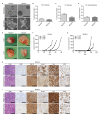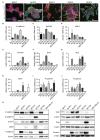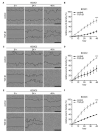Human Primary Breast Cancer Stem Cells Are Characterized by Epithelial-Mesenchymal Plasticity
- PMID: 33670400
- PMCID: PMC7918351
- DOI: 10.3390/ijms22041808
Human Primary Breast Cancer Stem Cells Are Characterized by Epithelial-Mesenchymal Plasticity
Abstract
Triple-negative breast cancer (TNBC) is one of the most aggressive subtypes of breast cancer, with only limited treatment options available. Recently, cancer stem cells (CSCs) have emerged as the potential drivers of tumor progression due to their ability to both self-renew and give rise to differentiated progeny. The CSC state has been linked to the process of epithelial-mesenchymal transition (EMT) and to the highly flexible state of epithelial-mesenchymal plasticity (EMP). We aimed to establish primary breast cancer stem cell (BCSC) cultures isolated from TNBC specimens. These cells grow as tumor spheres under anchorage-independent culture conditions in vitro and reliably form tumors in mice when transplanted in limiting dilutions in vivo. The BCSC xenograft tumors phenocopy the original patient tumor in architecture and gene expression. Analysis of an EMT-related marker profile revealed the concomitant expression of epithelial and mesenchymal markers suggesting an EMP state for BCSCs of TNBC. Furthermore, BCSCs were susceptible to stimulation with the EMT inducer TGF-β1, resulting in upregulation of mesenchymal genes and enhanced migratory abilities. Overall, primary BCSC cultures are a promising model close to the patient that can be used both in vitro and in vivo to address questions of BCSC biology and evaluate new treatment options for TNBC.
Keywords: cancer stem cells; epithelial-mesenchymal plasticity; epithelial-mesenchymal transition; triple-negative breast cancer.
Conflict of interest statement
The authors declare no conflict of interest.
Figures





References
-
- Wild C., Weiderpass E., Stewart B. In: World Cancer Report: Cancer Research for Cancer Prevention. Wild C., Weiderpass E., Stewart B., editors. International Agency for Research on Cancer; Lyon, France: 2020.
-
- Goldhirsch A., Winer E.P., Coates A.S., Gelber R.D., Piccart-Gebhart M., Thürlimann B., Senn H.-J. Personalizing the treatment of women with early breast cancer: Highlights of the St Gallen International Expert Consensus on the Primary Therapy of Early Breast Cancer 2013. Ann. Oncol. Off. J. Eur. Soc. Med. Oncol. 2013;24:2206–2223. doi: 10.1093/annonc/mdt303. - DOI - PMC - PubMed
MeSH terms
Substances
Grants and funding
LinkOut - more resources
Full Text Sources
Other Literature Sources
Miscellaneous

